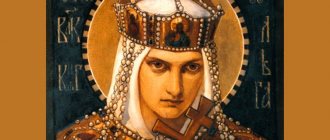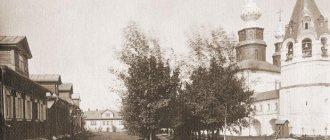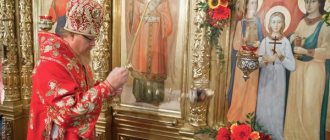Relics and veneration
As noted, the incorruptible remains rested for the longest time in the Slutsk Trinity Monastery. For a long time, the relics of the saint were located under the altar of the Spassky Church of the monastery. In 1904 they were moved to the so-called winter chapel of the monastery. And in 1912, the coffin was placed behind the right choir of the Holy Trinity Church, opposite the chapel in honor of the Holy Great Martyr Catherine. On the solea between the iconostasis and the coffin with the relics stood in an icon case the family icon of the Slutsk princes in a silver robe studded with precious stones. This icon is from the 19th-20th centuries. was revered locally, and according to the description of Archimandrite Afanasy (Vecherko), it was all hung with signs donated by pilgrims. Before the icon, on Saturdays throughout the year, before the liturgy, a prayer service was performed to the Most Holy Theotokos, combined with an akathist. Near the tomb stood a copper candlestick arshin high, with poured images of angels on three legs, for a brotherly candle weighing 1-2 pounds. This candlestick always stood on the salt near the coffin. The veneration of the saint and her relics never ceased. Initially, memorial services were held for her on September 17 of each year. There was another tradition: only female persons were involved in vesting the Saint in the tomb; even the abbot of the monastery could not be present at the vesting. Funds for re-vetting were always collected collectively by pious parishioners. Next to her were the Holy Relics of the infant martyr Gabriel of Zabludovsky. On February 21, 1930, a commission consisting of the head of the department of the Bobruisk executive committee Antonov, associate professor of BSU Chervakov, manager of the Bobruisk hospital Surov, representative of the church council of the Trinity Cathedral Pavlyukevich, church warden of the same Cathedral Krivodubsky, education inspector Ivanitsky, representative of the Slutsk City Council Sechko, in the presence of the Rector of the Trinity Bishop Nicholas Cathedral (Shemetilo) “inspected” the relics of the baby Gabriel and St. Sophia, Princess of Slutsk. The cancer was opened and an examination report was drawn up with a report and photographs attached. In its conclusions, the commission acknowledged the absence of special embalming of the bodies, and justified incorruption as “a typical example of natural mummification of a corpse.” Then the relics of the holy princess were taken to Minsk to the anatomical museum of the Faculty of Medicine of the BSU. During the occupation of Minsk by German troops, through the efforts of the ascetics, probably at the request of the rector of the Holy Spirit Cathedral in Minsk, Zhirovitsky archmangerite Seraphim (Shakhmut) (and with the permission of the occupation authorities), the relics were transferred to the Holy Spirit Cathedral in Minsk, although almost the entire occupation was protected by for threatening to be taken to Germany in the basement of one of the private houses in Minsk. Only after the war did they return to the Cathedral of the Holy Spirit. In the biography of Sofia Slutskaya, a rather difficult moment of this transfer is noted:
| “According to eyewitnesses and contemporaries of the events of 1941, the occupation authorities accepted the request to return the relics to the Church when they were discovered in the ruins of Minsk. And now, in the miraculously surviving building, there is a medical center. The faculty of the BSU (now Independence Square), the Wehrmacht services, which carried out an inspection and inventory of the surviving buildings, discovered the Shrine - the relics of the Saint. The patrol notified (apparently with the knowledge of the command) the church of the Minsk Holy Spiritual Cathedral, which was then a monastery church, about its find, about the satisfaction of a previously received request for the return of the relics.” Now the relics are openly located in the Holy Spirit Cathedral in Minsk. (pictured right) |
Biography
The last of the line of the Slutsk and Kopyl princes, descendants of the Grand Duke Olgerd (Olelkovichi), owner of the Slutsk Principality, (vassal of the Grand Duchy of Lithuania from 1326). Born May 1, 1585 (or 1586). She was the only daughter of Slutsk Prince Yuri Yuryevich from his marriage with the daughter of a Lithuanian nobleman Ekaterina Tenchinskaya from the Kishek family. Information about the baptism of the princess and the names of her successors has not been preserved. It was probably committed by the confessor of the Slutsk princes, Priest Malofey (Matthew) Stefanovich, rector of the St. Barbara Church of Slutsk. Accordingly, the place of celebration could have been either one of the castle churches of the Slutsk “Dzyadinets”, or the Varvariinsky temple itself. She lost her parents at the age of two: her father died on May 6, 1586; her mother, according to sources, died even earlier. Having been orphaned, Sofia became a rich heiress: she received a third of the family fortune. Over the course of just a few years, Sofia’s uncles, Alexander and Jan-Simeon, also died. They had no children, and all other possessions of the Olelkovich family passed to the girl. According to her grandfather's will, Sofia also becomes Princess Kopylskaya. She became the richest bride in the Polish-Lithuanian Commonwealth. The Khodkeviches, relatives on the female side, took guardianship over her (the grandmother of Princess Sofia Yuryevna, the mother of Catherine, and the wife of Nikolai Kishka was née Khodkevich). The princess spent her infancy and childhood in Berestye and Vilna: first the girl was looked after by the Zhmud elder Yuri Khodkevich, who took her to Vilna, then by the Vilna castellan, the Brest elder Jerome Khodkevich. Information has been preserved about the icon, part of the family inheritance, which the princess kept with her from infancy: the Protection of the Mother of God (in a rich robe). Later this icon accompanied the relics of the saint. It has not survived to this day.
Defense against Uniatism and church activities
The princess was actively involved in church affairs for the benefit of the Orthodox Church: in the Western Russian region, a church union with Rome was declared in 1596. At this time, the city of Slutsk belonged to her. The princess stood up to protect the people and Orthodox shrines from Uniate violence. Residents of the city could rally under the shadow of their shrines into the Slutsk Transfiguration Brotherhood in order to defend Orthodoxy. In addition, Sophia convinced her Catholic husband to obtain a charter from the King of Poland, which prohibited forcing her subjects to union. (Janusz confirmed these rights of Slutsk even after Sophia died, moving, in addition, due to the ongoing claims of Catholicism for hegemony to Calvinism). “So that churches, archimandrites, abbots, monasteries and brotherhoods in the principality of Slutsk and other possessions are preserved inviolably, without any change, in the complete freedom of their worship... the union in these churches should not be introduced in any violent or contrived way...” Thanks to this, the city Slutsk remained the only city in the Northwestern Territory that remained untouched by the Uniates. Together with her husband, Sofia also donated a lot and did charity work. The archives still preserve the letters of the Radziwill couple about donations to churches. On Mir-mountain of the Yazelsky parish, then Bobruisk district, Sofia built the Intercession Church at her own expense. With her own hands she embroidered the heaviest golden priestly vestments as a gift to the Churches (These vestments survived until the 20th century and are described, like the Gospel, reproduced by Yuri-3, the Polish researcher Smolinsky in 1903). They celebrate her piety in her lives. “With the participation of Princess Sophia, Slutsk remained a stronghold of Orthodoxy. Princess Sofia Yuryevna protected the Orthodox from all misfortunes as best she could. Orphaned, oppressed, persecuted co-religionists from various estates, persecuted for their steadfastness in Orthodoxy, flocked under her roof... Despite the dangers of the journey, she, along with pilgrims, visited numerous Temples on foot on the days of their patronal holidays.” In 1604 and 1608, the Radzivil couple suffered grief: their son Nicholas and daughter Catherine died in infancy. This fact is captured by Leibovich and Kotlubay. Research into the genealogy of the Radziwills, conducted by I. Zvaryka, confirmed this moment in the life of the Radziwills.
Canonization
Almost immediately after her death, Sophia began to be revered by the people as the patron saint of sick women preparing to become mothers. The relics turned out to be incorrupt, and miracles happened at the tomb. In 1848, a religious procession with the relics of the saint saved the city from cholera. In the biography of Fr. There is no evidence of an earlier church-wide canonization of the saint. But it is worth mentioning that in many sources of the early 20th century she was canonized locally in the Minsk Diocese. To the question of the canonization of the saint, it should be added that Orthodox scholars in Poland claim her possible canonization during the time of Peter Mohyla. Yes, and A. Trofimov in the book “Holy Wives of Rus'” points to the pre-revolutionary canonization of St. Sophia. The resolution of such issues by the documents of the Russian Orthodox Church is assigned to the jurisdiction of the Diocesan Commissions for Canonization. Officially by the Orthodox Church, Saint Sophia Princess of Slutsk (March 19 - April 1) was canonized by the Blessing of Bishop Pimen in the Cathedral of Belarusian Saints on April 3, 1984. The basis for inclusion in the Cathedral and further canonization was the report of Metropolitan Philaret of Minsk and Slutsk.
Death
Princess Sophia died from giving birth to a stillborn daughter at the age of 26 on March 19, 1612, in Omelevo, near the town of Igumen (Cherven). Her vast possessions went to her husband, the Radziwill family, including 7 fortresses and palaces and about 32 villages. She was buried in the Castle Holy Trinity Church of Slutsk, next to the place where her father, Prince Yuri Yuryevich, rested. On the outside of the coffin lid there is an inscription: “1612, March 19, the blessed Sophia, Princess Slutskaya Olelkovna Yuryevichovna Olgerdovna, presented herself to the Olgerd tribe and was laid to rest in the monastery of the Holy Life-Giving Trinity.” The death of his wife deeply wounded her husband, Prince Janusz. His close friend, who personally knew Princess Sofia, the poet Solomon Rysinsky, left the following lines in the “Epitaph” (Plament song on the death of Sofia):
| You are preserved in the Slutsk constellation, united, Among the Lithuanians, the brightest glory, the first daughter! Are you less of a knight than your great proud husband? What a force that suddenly came and took you away!... |
And after the death of his wife, Prince Janusz deeply respected the traditions bequeathed by his pious wife. And indeed, the influence of the memory of the couple Sophia and Janusz was so great that all the Radzivils, when they assumed reign in Slutsk, pledged themselves to preserve Orthodoxy in the region, although they themselves remained in a different faith.











